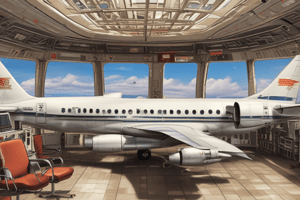Podcast
Questions and Answers
What is the primary purpose of establishing Minimum Sector Altitudes (MSA) and Terminal Arrival Altitudes (TAA) for each aerodrome?
What is the primary purpose of establishing Minimum Sector Altitudes (MSA) and Terminal Arrival Altitudes (TAA) for each aerodrome?
- To define the highest altitude at which an aircraft can fly during an instrument approach
- To determine the minimum descent altitude (MDA) for a specific approach procedure
- To provide a safe altitude for aircraft to descend below during instrument meteorological conditions (IMC)
- To ensure at least 300m (984ft) obstacle clearance within 25nm of the navigation aid, IAF or IF associated with the approach procedures (correct)
Under what conditions can an arriving aircraft descend below the Minimum Sector Altitude (MSA)?
Under what conditions can an arriving aircraft descend below the Minimum Sector Altitude (MSA)?
- When the aircraft is flying a visual approach
- Only when the aircraft is flying a published approach procedure
- When the aircraft is in contact with air traffic control
- When the aerodrome and underlying terrain are visible and will remain so, or the aircraft is under radar control (correct)
What is the typical distance from the navigation aid, IAF or IF within which MSA/TAA provides obstacle clearance?
What is the typical distance from the navigation aid, IAF or IF within which MSA/TAA provides obstacle clearance?
- 25nm (correct)
- 10nm
- 100nm
- 50nm
Where can pilots find the Minimum Sector Altitude (MSA) and Terminal Arrival Altitude (TAA) for a specific aerodrome?
Where can pilots find the Minimum Sector Altitude (MSA) and Terminal Arrival Altitude (TAA) for a specific aerodrome?
What is the typical altitude at which the instrument approach procedure begins?
What is the typical altitude at which the instrument approach procedure begins?
What is the primary purpose of establishing Decision Altitude/Height (DA/H)?
What is the primary purpose of establishing Decision Altitude/Height (DA/H)?
What is the primary requirement for maintaining the centreline of the runway during a precision approach?
What is the primary requirement for maintaining the centreline of the runway during a precision approach?
What is the primary difference between Category I and Category II precision approaches?
What is the primary difference between Category I and Category II precision approaches?
What is the primary purpose of the 'on board' computer systems (FMS) in a precision approach?
What is the primary purpose of the 'on board' computer systems (FMS) in a precision approach?
What is the primary characteristic of a Category IIIC precision approach?
What is the primary characteristic of a Category IIIC precision approach?
Flashcards are hidden until you start studying
Study Notes
Minimum Sector Altitudes (MSA) and Terminal Arrival Altitudes (TAA)
- MSA/TAA provide at least 300m (984ft) obstacle clearance within 25nm of the navigation aid, IAF, or IF associated with approach procedures.
- MSA/TAA is established for each aerodrome and is shown on all instrument charts.
- MSA/TAA is the lowest altitude permitted at the appropriate fix, typically the altitude at which the procedure begins.
- An arriving aircraft can descend below MSA only when:
- The aerodrome and underlying terrain are visible and will remain so.
- The aircraft is under radar control being radar vectored.
- The aircraft is flying a published approach procedure.
Types of Procedures
- Instrument procedures are defined by the guidance provided during an approach
- ICAO defines two types of procedures: Precision Procedures and Non-precision Procedures
Precision Approach
- Provides accurate track guidance (azimuth) during the final approach segment
- Provides information concerning height above the threshold of the runway (elevation)
- Requires external equipment (e.g. ILS, MLS, PAR, GLS) to provide the necessary data
- Ensures terrain clearance throughout the procedure by keeping the aircraft within a protected area
Decision Altitude (Height)
- The specific altitude at which a missed approach must be initiated if the required visual reference to continue the approach has not been established
- Calculated based on the Operator's declared aerodrome operating minima
- Defined in the Operations Manual
Precision Categories
- ICAO categories of precision approach systems based on accuracy of operation:
- Cat I: System minima 60m (200ft), DH ≥ 60m, RVR ≥ 550m or ground visibility ≥ 800m
- Cat II: System minima 30m (100ft), DH < 60m but ≥ 30m, RVR ≥ 350m
- Cat IIIA: No system minima, DH < 30m or no DH, RVR ≥ 200m
- Cat IIIB: No system minima, DH < 15m or no DH, RVR < 200m but ≥ 50m
- Cat IIIC: No system minima, no DH, no RVR requirements
Studying That Suits You
Use AI to generate personalized quizzes and flashcards to suit your learning preferences.




